
Planetary observation with Haley's Telescopes
Clicking into the above Cinemascope image is worthwile!
This gallery of planet images of my telescopes will be frequently
actualized and extended and can now watched
by this way
.

This page is arranged chronologically: New images you'll find at the
top and older ones more to the bottom. For a quick reference the links to
all planets of our solar system are located beside the planet thumbs:

Mercury images you'll find
here and
here as well as the
report of the Mercury transit
there. |

|

The latest image of the Moon done at the succesful night in June 2008
here. Another one at the
parade of planets. This image
here is a historic one.
Further images of the Moon you'll find
here,
here,
here,
here and
hier. |

Images from Mars 2005 are located
here, from 2003 there are images
here , or closer
here. |

Images of Jupiter are inserted
here,
here,
here, at
this place also with an
animation,
here, and
here. |

The Saturn image gallery consists exposures
here and
here again, as well as at
this place.
|

The only image of Uranus so far is located
here. |

There is now also an image of Neptun one can find it
here. |

I succeeded to ban Pluto
at the film. the 1st happy try is
here. |
|
The image in
the middle is showing the arrangement with D8 camcorder attached to the
telescope. All planetary images are done this way.
And now here are the links to my eclipse pages:


At June 6th early morning it was time again. The second and last
transit of Venus took place, at least in the live of all of us. The
first two thirds where not observable from Middle Europe. Ad nauseam a
front system with rain passed by. Nevertheless with a lot of hope the
"M1" mount equipped with the 3 1/2" refractor "Weisslichtsau" was being
placed at stage. The PST was at hand in a lurking position and a bright
stripe at horizon pledged hope. The rising sun into the foggy scenery and
small holes in the clouds produced a bit of suspense. There were at least
about 5 minutes useable conditions to experience visual and photographic
views with the Canon 350D "Photonensack"and the Herschel wedge. The following
images are showing a image of the event, done at 06:24 MESZ at our domestic
drive and of the setup also:
Transit of Venus
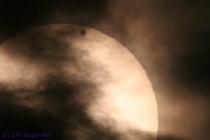 |
Equipment
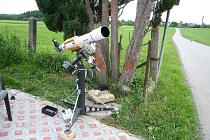 |
These are the first images of this action, there is more material.
The transit has been observed succesfully from many observers. At the
Astrotreff one can admire a great number of results. A great cross section
with my results also is showing in
this thread.
Instead of unfortunate conditions, the Coronograph pointed towards the antenna
during sunrise, Wolfgang Mitsch succeeded with a few impressions at the
Mt. Wendelstein Observatory. There is als a
small video clip.
Now we have to be a bit patient, the next transit of Venus will occur
at December 11th 2117.

A crystal clear evening at Mt. Wendelstein made the sighting of this four
heavenly bodies so close together at dusk possible. The first image shows the
chain of planets in an attractive sequence. The image to the right is a bit zoomed
in and documents Jupiter beside the fainter Mercury standing close above the
horizon. Both images have been done with a Casio QV5700:
Chain of planets
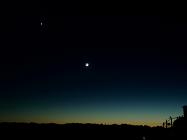 |
Jupiter and Mercury
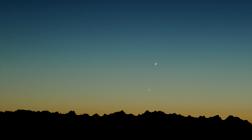 |

During two nights in a distance of 48 hours it was able to do
photographs of Pluto as stacks of a few 1min exposures in the focus of the Bismarck
telescope. The dwarf planet moved a few arcmins backwards, in the image
towards west, thus to the left. At first the two stacks with the marked
position of Pluto:
Am 29. Juni
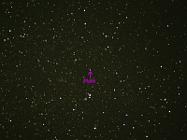 |
Am 01. Juli
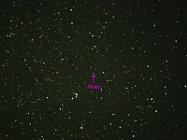 |
Different stereo images have been created from the two single frames.
The Gif animation is showing both frames blinking at overlap. Thus Pluto
is easy detectable as a jumping point. At the same way the dwarf planet,
like many asteroids also, has been discovered. With a device called blinking
comparator the film plates used at that time could be blinked like shown in
this animation:
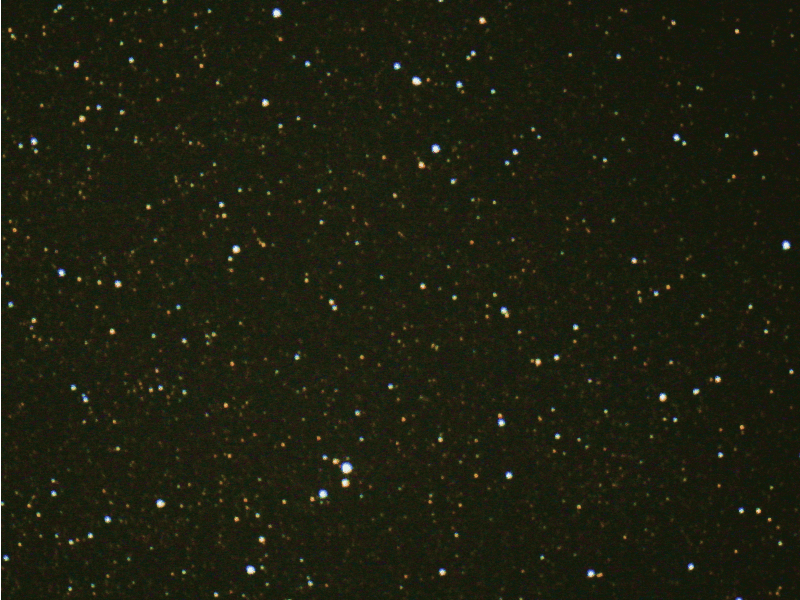
Now one can guess where the phrase from the "crucial point" could be
come from.
At least a stereo image where both single frames have to be
overlapped by cross eyed view, if one is able to use that technique.
If so Pluto seemes to float stereoscopic in front of the background:
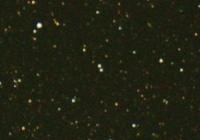

Neptune und Moon at June 29th
2008:
The second object out of the row of planets during this early
summer night is Neptune, similar to Pluto exposed as conventional deep sky
image focal with Bismarck. Not especially spectacular but Neptune is captured
with no doubt and easy to identify by its blue-greenish colour. Stacked out
of eleven single frames with 10 secs EOS 350d exposure time each. Slight crop.
Also the crescent of the Moon was photographed in this succesful night. A HDR
stack created out of five single frames with the "Photonensack" in the
primary focus of the Bismarck telescope. So details at the terminator as well
as on the limb of the Moon are visible which would be otherwise saturated:

During observation of
comet Holmes this shot of the Moon has been
created in Bismarck's focal plane with the Canon 350D:
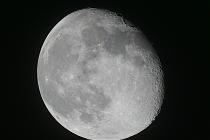

During a cloudy afternoon but with comfortable warm weather the
occultation of Venus through the Moon could be watched with Bismarck and the
3 1/2" guiding scope. The first row of images shows the ingress of Venus behind
the Moons dark side and the instrumentation at work:
Ingress
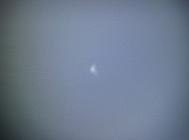 |
hugging the telescope
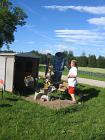 |
Moon sets...
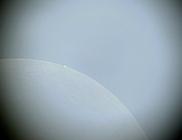 |
...Venus...
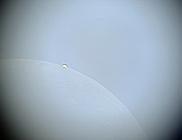 |
...free!
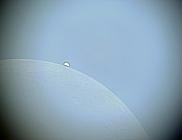 |
Since the whole occultation has find its way on a videotape, there is
here also a small
time lapse movie of the egress (5Mb).

With the 0.8m Telescope of the Mt. Wendelstein Observatory this image
of a shadow passage of Ganymede has been made. Made as a test with the imager
MONICA I've done a three colour composite. Although Jupiter had a declination
of -22° the result is pretty good:
Jupiter und Ganymede
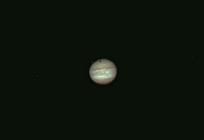 |

During this year 2005 at the beginning of November Mars reaches
again a spectacular opposition. During this opposition it approaches to a
distance of about 60 million kilometers. A few clips of mars are awaiting
their image processing with the established method. Here the first teaser:
Oktober 13th 2005
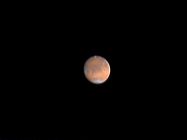 |
For comparison you can watch the great number of pictures done at
the opposition period 2003
here.

Uranus is observable better and better from year to year. To take
this image of the 3.6 arcsecond size planet appropriate seeing is
essential. With Bismarck Uranus is bright enough for the camcorder. The
tiny planetary disc was enlarged by the factor two.
Uranus
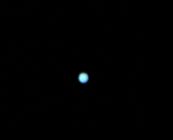 |

Saturn and Jupiter at
January 16th 2005:
Since Saturn is longer watchable here the matching clip of Jupiter
has been processed now and shows the shadow passage of the moons Europe and
Ganymede. Image processing technique like usual: D8 camcorder attached together
with 30mm Plössl at the Bismarck focuser, maximum optical zoom, stacking of the
best frames of an 1min clip with Registax and additional processing with Gimp.
Saturn
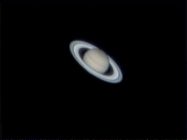 |
Jupiter
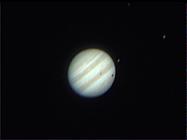 |

At the end of a nice "spechtling" night (more images at the
Bismarck gallery
) the lunar crescent flaunted at the morning sky above the
observatory. A good opportunity to make a mosaic out of a few single Ixus
images:
Lunar mosaic:
 |
Morning mood with Moon's crescent:
 |
6 images were taken through Bismarck for the mosaic. They've been
combined with The Gimp. Gabi is responsible for the shooting of the morning
mood short after the lunar photography. The panormic view was made out of
three images.

The outermost of the nine planets ist not only difficult to observe,
its brightness of only mag 14 makes a larger telescope like Bismarck
necessary. the unimpressive planet is not observable with the camcorder.
You have to make a deepsky exposure:
Pluto at April 22th 2004:
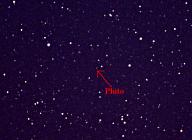 |
Comparison chart of this field:
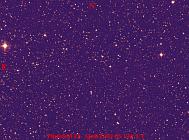 |
The left shot exposed 12 minutes in Bismarck's focus shows Pluto. It
can be identified only by comparison with a findingchart, taken from the
Digitized Sky Survey. This field of stars
shows a zoomed cutout of the Bismarck image. The copyright of the DSS
data is at the STSci. With this resource the position of Pluto can be
identified without doubt.

I found a series of images, done in spring 2004 with a helping hand
of the Casio 5700 and the 2 1/2 inch Schiefspiegler at the Wendelstein
mountain. They are of respectable image quality so the making of a moon's
mosaic was absolutely worth while:
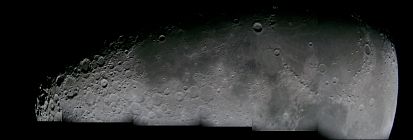
This mosaic consists of 6 focal shots, made by projection method at
the Schiefspiegler. Composed were these images with The Gimp. The next row
shows the meanwhile proved and tested instrumentation. Check out the mass
of snow, it was at the end of March!
View towards east
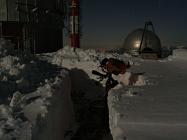 |
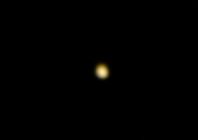 |
Equipment in snow
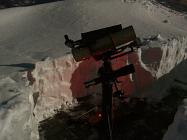 |
The image of mercury is done at the moonshots evening. It is not
really spectacular but shows the threequarter filled Mercury disk. The
exposures of the moon at the next row are done at the same time, the
crescent is from December 2004 but from the same location. The totals
of the moon are shot through the 400mm telelens. The image in the middle
shows the northern hemisphere of the Moon starting
from the remarkable crater Copernicus till Plato and the Valley of the
Alps close to the northern limb located down in the view of an inversive
telescope. This image is a mosaic of two images of the mentioned image
series.
March 29th
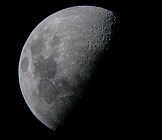 |
March 30th
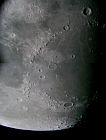 |
December 15th
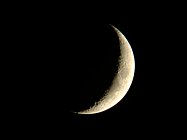 |
At the evening of December 15th 2004 further images were made. They
could regarded at the
Astrophoto gallery. Moreover this images demonstrates that it is
possible to make impressive shots through the 60mm diameter optics of the
Schiefspiegler and the 400mm telelens.
There is an own category about the historic 2 3/8" Schiefspiegler at the
technic page.
There you'll find also more informations about handcrafted accessories and
telescope modifications.

Venus got more and more attraction in 2004. After flaunting
at the evening sky in spring she transited the disk of the Sun at June 8th.
Finally a few still missing images of the transit which were
extracted from the video made through the Bismarck telescope. The poor
optical quality of the full size filter is responsible for an impressive
demonstration of the black drop phenomenon. In the 3 1/2" guiding scope
with the better glass filter no drop phenomenon was visible:
Before egress
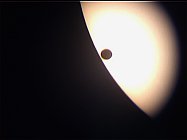 |
Black drop
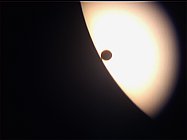 |
moments later
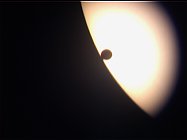 |
During the egress I encountered visually the aureolis effect. At
first I believed in an optical deception. But the effect is real and was
captured on video because the exposure time was slightly higher than
recommended. The aureolis is the backlit atmosphere of Venus:
Aureolis
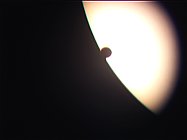 |
still visible
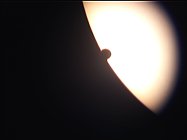 |
Here a few impressions from the scenery at the Bismarck Observatory
were an illustrious round was assembled for observation of the Transit.
Beside Gabi, Uli and Franz we had a guest from canada, Dennis. The first
two images shows the whole scenery with Bismarck in the foreground in the
mornings ready for ingress and Transit. It was simultaneously videotaped
and photographed with the Canon Ixus. Samti came also to use and Uli
brought his 3 1/2" refractor. He observed with a Herschel wedge. Gabi
demonstrates that the Transit was visible with naked eyes through eclipse
spectacles. The fourth image shows Franz and Dennis with their equipment
(10" SC and Maksutov). At the fifth and at the last but one image one can
see the whole armament at the Bismarck scope with guiding scope, 400mm tele
lens, Maksutov at the counterweight axis and both cameras which mapped the
Transit.The last shot was taken short after end of egress. The heat raised
up to 30 degrees C on this perfect day.
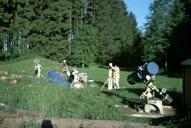
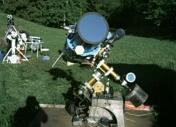
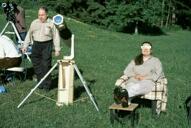
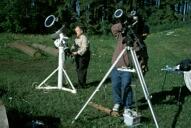
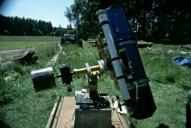
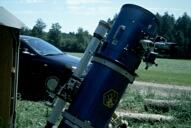
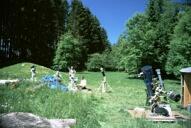
Data gained from a 70 image sequence with
the Canon Ixus:
Here one arrive at a mpeg version of this
animation (Filesize ca 600 Kb). Clicking into the image of the Transit
taken short before beginning of egress you reach a GIF animation of
the event (Filesize ca 800 Kb):

At the Wendelstein summit the Transit has benn observed also.
Here is the link to the images, taken at the
Koronograph. A few of Uli's great pictures can be admired
here
Now an exposure of Venus from this May about
three weeks before Transit, as the evening star still showed an explicit
croissant form. This shot was taken with the help of Christina:
Venus May.17th 2004
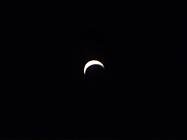 |
Another highlight in the observing season winter 2003/2004 was a
spectacular
Green Flash of Venus seen from the Mt. Wendelstein.
This 30 secs animation shows a summary of this impressive and extremely
rare event. The Green Flash itself is shown twice, first in real speed,
then in slow motion. Filesize is 5 Mb!

Jupiter at...
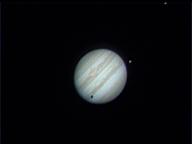 |
...January 24th 2004
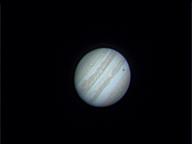 |
Oktober 26th 2003
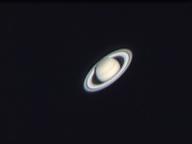 |
The first two pictures are part of an
animation of a passage of Ganymedes shadow and the following transit
of this moon in front of Jupiter. The two images of Jupiter are snapshots
of this event. Sporadically the seeing was about 1 arcsecond. Look at the
dark color of Ganymede during his transit. The image of Saturn aside is
done with the the same technic like the images of Jupiter and also the
exposures of Mars at the Mars
page.
Another highlight in the observing season winter 2003/2004 was a
spectacular
Green Flash of Venus seen from the Mt. Wendelstein.
This 30 secs animation shows a summary of this impressive and extremely
rare event. The Green Flash itself is shown twice, first in real speed,
then in slow motion. Filesize is 5 Mb!


By now the Opposition of Mars 2003 is history. All images for this
issue you find by clicking into the image of Mars or
here !
The Association of Lunar and Planet Observers (A.L.P.O.) offers not
only informations to the subject Mars. Informations about other objects in
the solar system are also available.
Here is the link to the A.L.P.O. start page.

Golden handle:
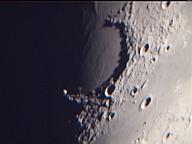 |
Beside the summerly hunting for Mars the one or other nice vision
of Moon was taken away, here the Sinus Iridium at the last daylight.

This picture of the transit is done from an added series of images
with the D8 camcorder. The further processing is done with The Gimp. The
solar filter of the Bismarck Telescope has almost moderate qualitiy. This
is visible in the imaging quality.
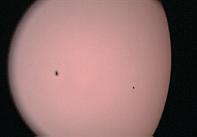
|
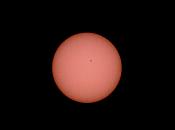
|
| Exposure of the Mercury transit with a normal camera through the
Bismarck Telescope. |
35 mm camera shot through the 3 1/2 inch guiding scope. |
A video of the egress is visible
here
(MPEG format, 1,4 Mb).
This row of images shows the instrumentation for the observation of
the transit. Beside the main scope Bismarck the 3 1/2 inch guiding
telescope comes to use. Like during normal solar observation both
telescopes are covered with solar filters. Photographs at the guiding scope
are taken with a normal 35 mm camera.
What happens during a transit: The planet Mercury, a tiny 12
arcsecond dot passes by in front of the Sun. The situation is exactly the
same like during a solar eclipse. The covering of the Sun's disk is much
more smaller than during a solar eclipse but Mercury is far more distant
from Earth than the Moon.

Shadow passage of Jupiter's moon Io March
4th 2003:
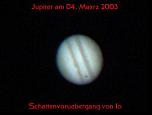
A time lapse video of the passage is visible
here
. (MPEG format 1.64 Mb)


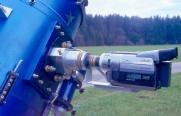

Jupiter is taken with my Sony D8 camcorder through Bismarck with
eye piece projection. Singular video frame, taken at November 21st 2001.
The magnification is according to 300 times visual. The shadow at the
giant planet belongs to its moon Europa. Similar exposure dates are
applying for Saturn. You get more information by clicking into the small
Saturn image. The middle picture shows the array for taking such exposures.

During the observation campaign of
comet Halley this shot of the young Moon and
Venus has been created through a 400mm telelens south of the Boca de Tauce
at Tenerife during dusk:
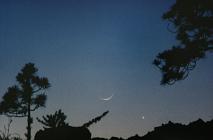












 To Solar Eclipse page:
To Solar Eclipse page: To Lunar Eclipse page:
To Lunar Eclipse page:










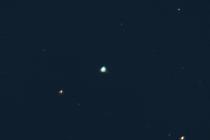
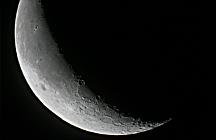












































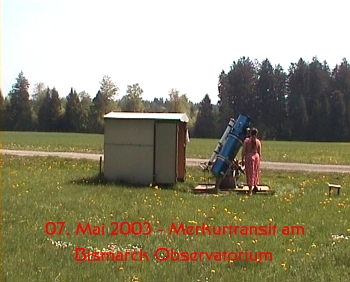
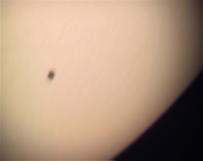


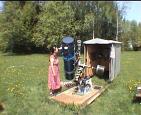
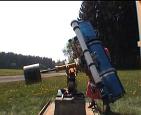
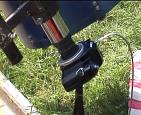
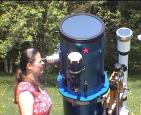




 To Astrophoto gallery
To Astrophoto gallery To Bismarck start page
To Bismarck start page To Bismarck gallery.
To Bismarck gallery. To Christina and ULT page
To Christina and ULT page To main page
To main page
















